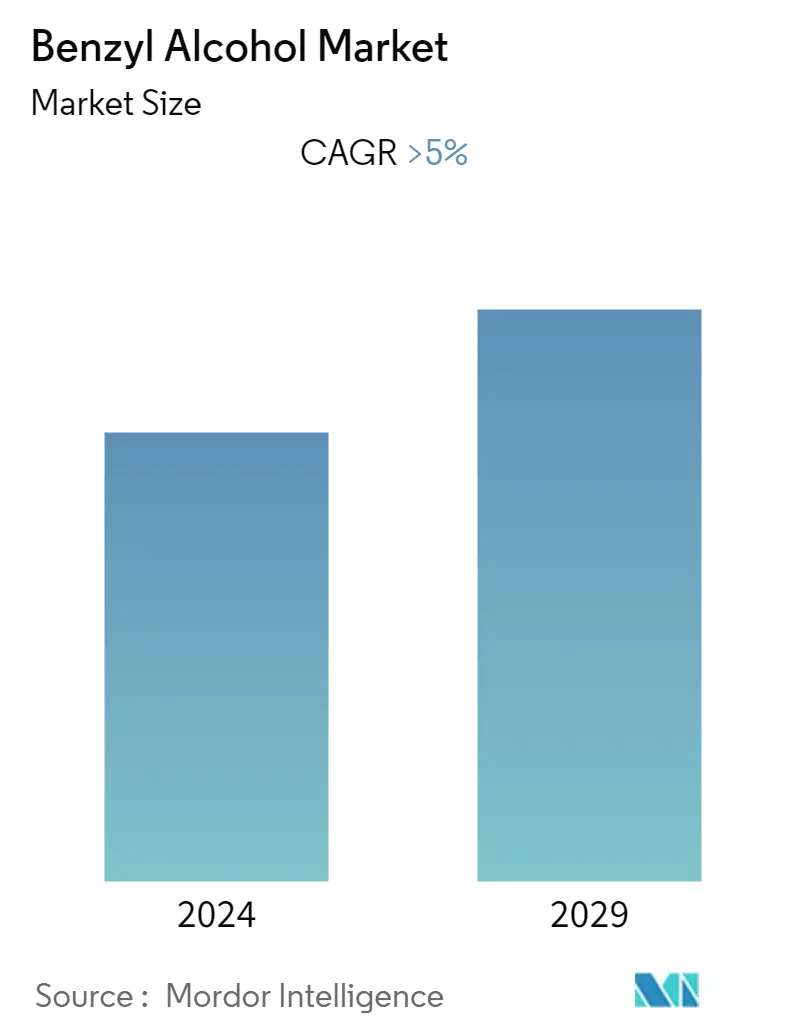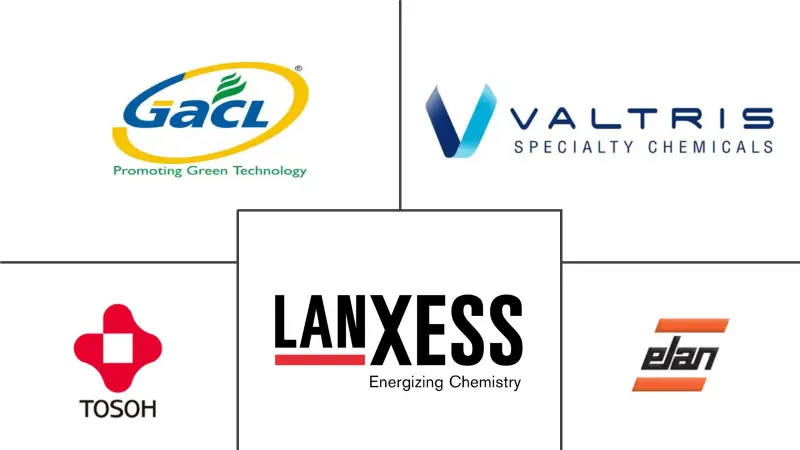Market Size of Benzyl Alcohol Industry

| Study Period | 2019 - 2029 |
| Base Year For Estimation | 2023 |
| CAGR | 5.00 % |
| Fastest Growing Market | Asia Pacific |
| Largest Market | Asia Pacific |
| Market Concentration | Low |
Major Players
*Disclaimer: Major Players sorted in no particular order |
Benzyl Alcohol Market Analysis
The global benzyl alcohol market is projected to register a CAGR of over 5% during the forecast period.
- COVID-19 impacted most industries worldwide. Excluding pharmaceutical applications, the demand for benzyl alcohol in cosmetics decreased in 2020 due to the lockdown scenario and halted production units. However, now the market is stable and growing steadily.
- Over the short term, the increasing demand from the food and beverage, cosmetics, and personal care industries is expected to drive the market's growth. On the flip side, a high concentration of benzyl alcohol causes toxic effects on humans and hinders the market's growth.
- The increasing demand for benzyl alcohol as anti-parasite medicine and a common preservative in injectable drugs and the product's growing popularity because of its wide applications, fragrance component, viscosity-decreasing agent, and preservatives accelerate the benzyl alcohol market growth. The use of benzyl alcohol in preservatives (2%), solubilizing agents (5%) and disinfectants (10%) and its extensive use in antibiotics, anti-inflammatory products, or neuroleptics to reduce pain further influence the benzyl alcohol market.
- Additionally, expansion of the pharmaceutical sector, consumption of aromatic solvents for drug formulation in the pharmaceuticals sector, and surge in investment positively affect the benzyl alcohol market. Furthermore, research and development and intensification of nitro benzaldehydes synthesis from benzyl alcohol extend profitable opportunities to the benzyl alcohol market players in the forecast period.
- Asia Pacific represents the largest market and is expected to be the fastest-growing market over the forecast period due to the increasing consumption from countries such as China, India, and Japan.
Benzyl Alcohol Industry Segmentation
Benzyl alcohol is a colorless and mild odor aromatic alcohol that is mainly manufactured from the hydrolysis of benzyl chloride and hydrogenation of benzaldehyde. It is mainly used as a solvent in paint and coatings formulations and as a flavoring agent in the food and beverage industries.
The benzyl alcohol market is segmented by end-user industry and geography. By end-user industry, the market is segmented into cosmetics and personal care, paints and coatings, chemical processing, pharmaceuticals, food and beverage, and other end-user industries. The report also covers the market size and forecasts for the benzyl alcohol market in 15 countries across major regions.
For each segment, the market sizing and forecasts have been done based on volume (metric ton).
| End-user Industry | |
| Cosmetics and Personal Care | |
| Paints and Coatings | |
| Chemical Processing | |
| Pharmaceutical | |
| Food and Beverage | |
| Other End-user Industries |
| Geography | |||||||
| |||||||
| |||||||
| |||||||
| |||||||
|
Benzyl Alcohol Market Size Summary
The benzyl alcohol market is experiencing steady growth, driven by increasing demand from various industries such as food and beverages, cosmetics, and personal care. Despite the initial impact of COVID-19, which led to a temporary decline in demand, the market has stabilized and is expanding. Benzyl alcohol's versatility as a preservative, solubilizing agent, and fragrance component contributes to its rising popularity. The pharmaceutical sector's expansion and the use of benzyl alcohol in drug formulation further bolster market growth. However, the market faces challenges due to the toxic effects of high concentrations of benzyl alcohol on humans. The Asia-Pacific region, particularly China, India, and Japan, is expected to be the fastest-growing market, driven by increased consumption in end-user sectors like paints and coatings, adhesives, and cosmetics.
The food and beverage industry significantly influences the benzyl alcohol market, with the demand for food additives and preservatives derived from benzyl alcohol expected to rise. The paints and coatings industry, where benzyl alcohol serves as a general solvent, is also projected to grow, supported by increased construction activities in China and India. Additionally, the automotive industry's demand for paints and coatings in China contributes to the market's expansion. The market is characterized by fragmentation, with key players including Gujarat Alkalies and Chemical Limited, Elan Chemical, Lanxess, Tosoh Corporation, and Valtris Specialty Chemicals. Regulatory developments, such as the Canadian government's proposal to add benzyl alcohol to its toxic substances list, may pose challenges, but the overall market outlook remains positive due to ongoing investments and technological advancements.
Benzyl Alcohol Market Size - Table of Contents
-
1. MARKET DYNAMICS
-
1.1 Drivers
-
1.1.1 Increasing Demand from the Food and Beverage Industry
-
1.1.2 Growing Demand from the Cosmetics and Personal Care Industry
-
-
1.2 Restraints
-
1.2.1 High Concentration of Benzyl Alcohol Causing Toxic Effects on Humans
-
1.2.2 Other Restraints
-
-
1.3 Industry Value Chain Analysis
-
1.4 Porter's Five Forces Analysis
-
1.4.1 Bargaining Power of Suppliers
-
1.4.2 Bargaining power of Buyers
-
1.4.3 Threat of New Entrants
-
1.4.4 Threat of Substitute Products and Services
-
1.4.5 Degree of Competition
-
-
-
2. MARKET SEGMENTATION (Market Size in Volume)
-
2.1 End-user Industry
-
2.1.1 Cosmetics and Personal Care
-
2.1.2 Paints and Coatings
-
2.1.3 Chemical Processing
-
2.1.4 Pharmaceutical
-
2.1.5 Food and Beverage
-
2.1.6 Other End-user Industries
-
-
2.2 Geography
-
2.2.1 Asia Pacific
-
2.2.1.1 China
-
2.2.1.2 India
-
2.2.1.3 Japan
-
2.2.1.4 South Korea
-
2.2.1.5 Rest of Asia Pacific
-
-
2.2.2 North America
-
2.2.2.1 United States
-
2.2.2.2 Canada
-
2.2.2.3 Mexico
-
-
2.2.3 Europe
-
2.2.3.1 Germany
-
2.2.3.2 United Kingdom
-
2.2.3.3 Italy
-
2.2.3.4 France
-
2.2.3.5 Rest of Europe
-
-
2.2.4 South America
-
2.2.4.1 Brazil
-
2.2.4.2 Argentina
-
2.2.4.3 Rest of South America
-
-
2.2.5 Middle-East and Africa
-
2.2.5.1 Saudi Arabia
-
2.2.5.2 South Africa
-
2.2.5.3 Rest of Middle-East and Africa
-
-
-
Benzyl Alcohol Market Size FAQs
What is the current Benzyl Alcohol Market size?
The Benzyl Alcohol Market is projected to register a CAGR of greater than 5% during the forecast period (2024-2029)
Who are the key players in Benzyl Alcohol Market?
Valtris Specialty Chemicals, LANXESS, Elan Chemical, Gujarat Alkalies and Chemical Limited and Tosoh Corporation are the major companies operating in the Benzyl Alcohol Market.

